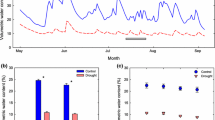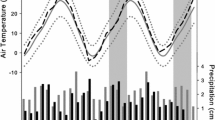Abstract
Global warming accelerates land surface drying, increasing the incidence of extreme climatic events such as severe droughts with detrimental effects on ecosystem functions and structure. We investigated the effects of an imposed severe drought (24 days) on fully established synthesized grassland communities with three species richness (S) levels (one, three or nine species), grown for 3 years at either ambient air temperatures (unheated) or ambient +3 °C (heated). Since water supply during these 3 years was equal in all treatments, heated communities experienced more frequent, short mild droughts, but it was unknown whether this conferred greater or smaller resistance for facing prolonged droughts. During the 24-day drought period, soil matric potential decreased in a similar way over time in both temperature treatments and was lower at increasing S-levels. Although green vegetation cover was significantly reduced by the drought in both temperature treatments, the decrease was higher in heated than unheated communities indicating a lower resistance of heated communities to the drought. After only 13 days of recovery, green vegetation cover of both temperature treatments approached values similar to those observed before the imposed drought, suggesting similar resilience in both treatments. Above-ground biomass was reduced by elevated temperature, consistently in all S-levels, showing that the drought period did not change the biomass production patterns observed in the treatments before the imposed drought. Our results suggest that, regardless of the continuous exposure to elevated temperatures and associated short mild droughts, heated communities had not developed clear mechanisms to better cope with extended summer droughts.






Similar content being viewed by others
References
Aarssen LW (1997) High productivity in grassland ecosystems: affected by species diversity or productive species? Oikos 80:183–184
Berendse F (1982) Competition between plant populations with different rooting depths. III. Field experiments.. Oecologia 53:50–55
Bruun HH, Ejrnæs R (2000) Classification of dry grassland vegetation in Denmark. J Veg Sci 11:585–596
Chapin FS, Walker B, Hobbs RJ, Hooper DU, Lawton JH, Sala OE, Tilman D (1997) Biotic control over the functioning of the ecosystems. Science 277:500–504
Chaves MM, Pereira JS, Maroco J, Rodrigues ML, Ricardo CPP (2002) How plants cope with water stress in the field. Photosynthesis and growth. Ann Bot 89:907–916
Choi K, Lee G, Han YJ, Bunn JM (1995) Tomato maturity evaluation using color image analysis. Transactions ASAE 38:171–176
Cornelis WM, Khlosi M, Hartmann R, Van Meirvenne M, De Vos B (2005) Comparison of unimodal analytical expressions for the soil–water retention curve. Soil Sci Soc Am J 69:1902–1911
De Boeck HJ, Lemmens CMHM, Bossuyt H, Malchair S, Carnol M, Merckx R, Nijs I, Ceulemans R (2006) How do climate warming and plant species richness affect water use in experimental grasslands? Plant Soil 288:249–261
De Boeck HJ, Lemmens CMHM, Gielen B, Bossuyt H, Malchair S, Carnol M, Merckx R, Ceulemans R, Nijs I (2007a) Combined effects of climate warming and plant diversity loss on above- and below-ground grassland productivity. Environ Exp Bot 60:95–104
De Boeck HJ, Lemmens CMHM, Vicca S, Van den Berge J, Van Dongen S, Janssens IA, Ceulemans R, Nijs I (2007b) How do climate warming and species richness affect CO2 fluxes in experimental grasslands? New Phytol 175:512–522
Flexas J, Bota J, Galmes J, Medrano H, Ribas-Carbo’ M (2006) Keeping a positive carbon balance under adverse conditions: responses of photosynthesis and respiration to water stress. Physiol Plantarum 127:343–352
Fridley JD (2001) The influence of species diversity on ecosystem productivity: how, where, and why? Oikos 93:514–526
Gulmon SL, Chiariello NR, Mooney HA, Chu CC (1983) Phenology and resource use in three co-occuring grassland annuals. Oecologia 58:33–42
Huston MA (1997) Hidden treatments in ecological experiments: re-evaluating the ecosystem function of biodiversity. Oecologia 110:449–460
IPCC, Intergovernmental Panel on Climate Change (2007a) Climate change 2007: impacts, adaptation and vulnerability. Working Group II. Contribution to the Intergovernmental Panel on Climate Change IV Assessment Report. Summary for policymakers
IPCC, Intergovernmental Panel on Climate Change (2007b) Climate change 2007: the physical science basis. Summary for policymakers. Contribution of Working Group I to the fourth assessment report of the Intergovernmental Panel on Climate Change
Kahmen A, Perner J, Buchmann N (2005) Diversity-dependent productivity in semi-natural grasslands following climate perturbations. Funct Ecol 19:594–601
Lemmens CMHM, De Boeck HJ, Gielen B, Bossuyt H, Malchair S, Carnol M, Merckx R, Nijs I, Ceulemans R (2006) End-of-season effects of elevated temperature on ecophysiological processes of grassland species at different species richness levels. Environ Exp Bot 56:245–254
Littell RC, Milliken GA, Stroup WW, Wolfinger RD, Schabenberger O (2006) SAS® for mixed models, 2nd edn. SAS Institute, Cary, NC
Loreau M, Hector A (2001) Partitioning selection and complementarity in biodiversity experiments. Nature 412:72–76
Loreau M, Downing A, Emmerson M, Gonzalez A, Hughes J, Inchausti P, Joshi J, Norberg J, Sala O (2002) A new look at the relationship between diversity and stability. In: Naeem S, Loreau M, Inchausti P (eds) Biodiversity and ecosystem functioning. Oxford University Press, Oxford, pp 79–91
Marchand FL, Nijs I, Heuer M, Mertens S, Kockelbergh F, Pontailler J-Y, Impens I, Beyens L (2004) Climate warming postpones senescence in high-artic tundra. Arctic, Antarctic, Alpine Res 36:390–394
Pfisterer AB, Schmid B (2002) Diversity-dependent production can decrease the stability of ecosystem functioning. Nature 416:84–86
Rodrigues ML, Pacheco CMA, Chaves MM (1995) Soil–plant water relations, root distribution and biomass partitioning in Lupinus albus L. under drought conditions. J Exp Bot 46:947–956
Roscher C, Temperton VM, Scherer-Lorenzen M, Schmitz M, Schumacher J, Schmid B, Buchmann N, Weisser WW, Schulze E-D (2005) Overyielding in experimental grassland communities—irrespective of species pool or spatial scale. Ecol Letters 8:419–429
Tang L, Tian L, Stewart BL (2000) Color image segmentation with genetic algorithm for in field weed sensing. Transactions ASAE 43:1019–1027
Tilman D, Downing JA (1994) Biodiversity and stability in grassland. Nature 367:363–365
Tilman D, Reich PB, Knops JMH (2006) Biodiversity and ecosystem stability in a decade-long grassland experiment. Nature 441:629–632
Van Peer L, Nijs I, Bogaert J, Verelst I, Reheul D (2001) Survival, gap formation, and recovery dynamics in grassland ecosytems exposed to heat extremes: the role of species richness. Ecosystems 4:797–806
Van Peer L, Nijs I, Reheul D, De Cauwer B (2004) Species richness and susceptibility to heat and drought extremes in synthesized grassland ecosystems: compositional vs. physiological effects. Funct Ecol 18:769–778
Yachi S, Loreau M (1999) Biodiversity and ecosystem productivity in a fluctuating environment: the insurance hypothesis. Proc Nat Acad Sci USA 96:1463–1468
Acknowledgements
This research was funded by the Fund for Scientific Research—Flanders (Belgium) as project “Effects of biodiversity loss and climate warming on carbon sequestration mechanisms in terrestrial ecosystems” (contract G.0434.03N). C. Zavalloni is a beneficiary of a Marie Curie International Reintegration Grant (contract MIRG-CT-2005-031109), which partially financed this study. H.J. De Boeck holds a grant from the Institute for the Promotion of Innovation by Science and Technology in Flanders and B. Gielen is a post-doctoral researcher of the Fund for Scientific Research—Flanders (Belgium). We gratefully thank N. Calluy and F. Kockelbergh for technical assistance, prof. S. Van Dongen for statistical advice, and K. Maguylo for improving the English.
Author information
Authors and Affiliations
Corresponding author
Additional information
Responsible Editor: Tibor Kalapos.
Rights and permissions
About this article
Cite this article
Zavalloni, C., Gielen, B., Lemmens, C.M.H.M. et al. Does a warmer climate with frequent mild water shortages protect grassland communities against a prolonged drought?. Plant Soil 308, 119–130 (2008). https://doi.org/10.1007/s11104-008-9612-6
Received:
Accepted:
Published:
Issue Date:
DOI: https://doi.org/10.1007/s11104-008-9612-6




